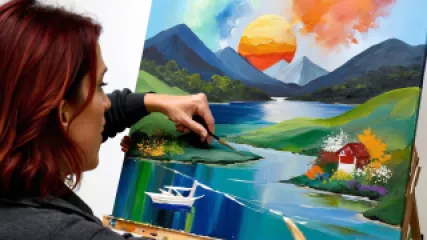How Art Therapy Helped Sarah Overcome Trauma
How Art Therapy Helped Carroll Lambert Overcome Trauma
A Journey of Healing and Resilience: An Interview with Carroll Lambert
Art has a transformative power that extends beyond the canvas or the sculptor's tools. It has the ability to heal, empower, and provide a voice for those who have experienced trauma. In this poignant interview, we sit down with Carroll Lambert, a survivor of domestic abuse, to explore how the power of art therapy has been instrumental in their journey towards healing and reclaiming their life.
Uncovering the Path to Healing
Carroll's story is one of resilience and determination. After enduring years of emotional and physical abuse within their relationship, they found themselves at a crossroads, searching for a way to regain a sense of control and move forward.
"The trauma I experienced left me feeling lost, disconnected, and afraid to trust myself," Carroll recounts. "I knew I needed to find a way to process the pain, but traditional talk therapy just wasn't resonating with me."
It was during this difficult time that Carroll stumbled upon the transformative power of art therapy. Encouraged by a close friend, they enrolled in a local expressive art workshop, uncertain of what to expect.
The Transformative Power of Art Therapy
As Carroll began to explore the various mediums of art, they found a newfound sense of freedom and expression. "The first time I picked up a paintbrush, it was as if a weight had been lifted from my shoulders," they reflect. "The act of creating, of allowing my emotions to flow freely onto the canvas, was incredibly liberating."
Through the guidance of the art therapist, Carroll was able to delve deeper into their emotional landscape, using art as a conduit for processing the trauma they had experienced. "The therapist encouraged me to experiment with different materials and techniques, to let my intuition guide the creative process," they explain. "It was a safe space where I could explore my feelings without judgment or expectation."
Reclaiming Narrative and Finding Empowerment
As Carroll continued to engage in art therapy, they began to witness a profound transformation within themselves. The act of creating art allowed them to regain a sense of control and agency over their own story.
"Through the art, I was able to reclaim my narrative and explore the complexities of my experience," Carroll says. "I could express the full range of my emotions – the pain, the fear, the anger, and the hope – without feeling the need to censor or dilute them."
The process of creating art also provided Carroll with a sense of empowerment and resilience. "Each piece I made was a testament to my strength and my determination to heal," they reflect. "It was a tangible reminder that I was not defined by the trauma I had endured, but by the courage and perseverance I was cultivating within myself."
Art as a Coping Mechanism and Ongoing Support
As Carroll's journey of healing continued, they found that art therapy had become an invaluable coping mechanism and source of ongoing support. "Whenever I felt overwhelmed or triggered, I would turn to my art supplies," they explain. "The act of creating allowed me to process my emotions in a healthy and constructive way, without resorting to destructive behaviors."
The benefits of art therapy extended beyond the individual sessions as well. Carroll began to incorporate art-making into their daily routine, finding it to be a powerful tool for self-expression and stress management.
"There's something about the act of creating that just grounds me and helps me feel more centered," Carroll says. "Whether it's sketching in my journal, experimenting with new mediums, or collaborating on a group project, the creative process has become an integral part of my self-care regimen."
Building a Supportive Community
In addition to the personal benefits of art therapy, Carroll also found that the experience of sharing their art and their story within a supportive community was deeply impactful.
"The art workshops I attended were more than just a place to create," they explain. "They were a safe haven, a community of individuals who understood the transformative power of art and were dedicated to supporting one another's healing journeys."
Carroll recounts the profound sense of connection and validation they felt when sharing their artwork with the group. "There was something incredibly powerful about having my experiences validated and my art celebrated by people who truly understood what I was going through," they say. "It was a reminder that I was not alone in my struggle, and that there was a community of individuals who were committed to healing and growth."
A Message of Hope and Inspiration
As Carroll reflects on their journey, they are eager to share a message of hope and inspiration with others who may be struggling with the aftermath of trauma.
"Art therapy has the power to transform lives," they assert. "It's not just about creating pretty pictures or fancy sculptures – it's about uncovering your own resilience, reclaiming your narrative, and finding a pathway to healing."
Carroll emphasizes the importance of being open-minded and willing to explore different modalities of therapy. "Don't be afraid to try something new, even if it feels uncomfortable at first," they advise. "The most important thing is to find what resonates with you and to commit to the process of self-discovery and growth."
For Carroll, the journey of healing through art has been a profound and life-changing experience. "Art therapy has given me the tools to navigate my trauma, to process my emotions, and to emerge stronger and more resilient than ever before," they say. "It's a testament to the power of creativity, self-expression, and the human spirit to overcome even the most daunting of challenges."
Embracing the Transformative Power of Art
Carroll's story is a powerful reminder of the transformative power of art therapy in the healing process. By providing a safe and supportive space for self-expression, art therapy has the ability to empower individuals, facilitate emotional processing, and foster a sense of resilience and post-traumatic growth.
As more and more people recognize the benefits of art therapy in addressing mental health concerns, including the treatment of trauma, it is clear that this holistic approach to healing has the potential to positively impact countless lives. By embracing the creative process and allowing it to guide us towards personal growth and self-discovery, we can unlock a deeper understanding of ourselves and our experiences, and ultimately, find the strength to overcome even the most daunting of challenges.
If you or someone you know is struggling with the aftermath of trauma, please don't hesitate to seek support. There are numerous resources and organizations available that specialize in trauma-informed care and expressive art therapies. Remember, you are not alone, and with the right support and tools, healing is possible.






